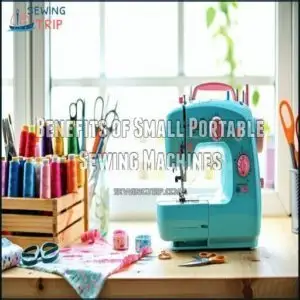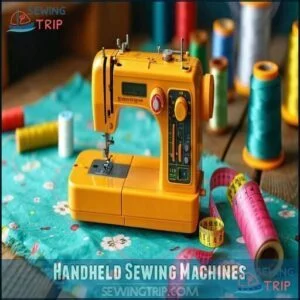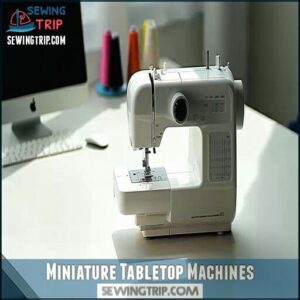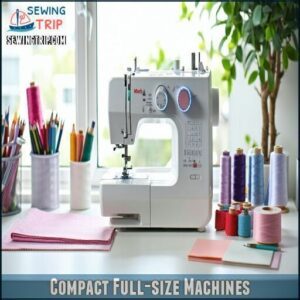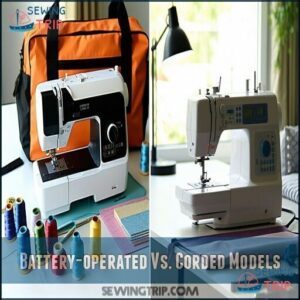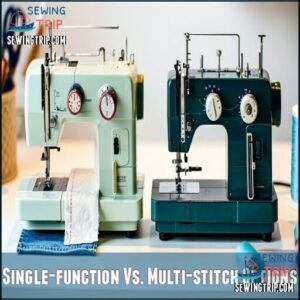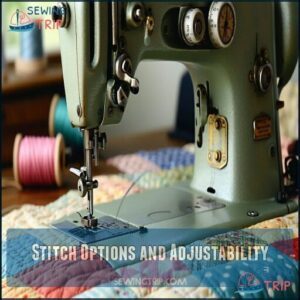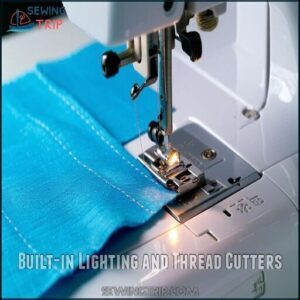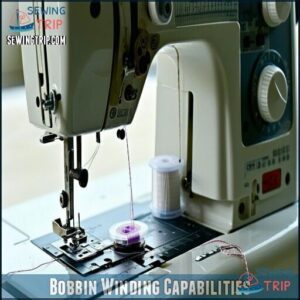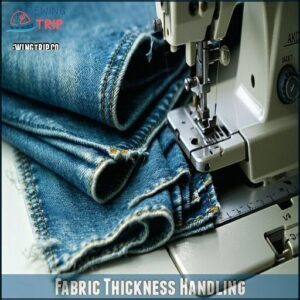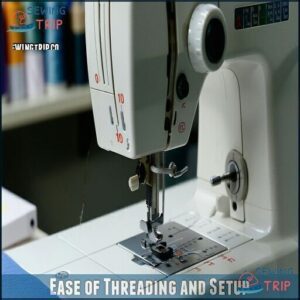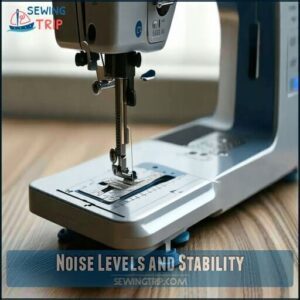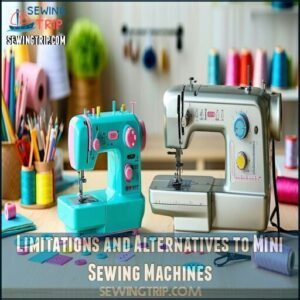This site is supported by our readers. We may earn a commission, at no cost to you, if you purchase through links.
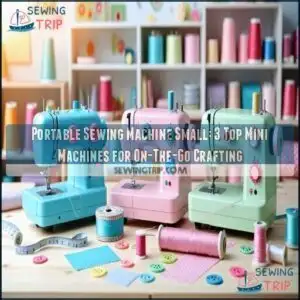
Weighing just a few pounds, they’re easy to store and carry—whether it’s to a class or just across the room. Handheld machines are great for fixing hems on the fly, while miniature tabletop versions offer more stability.
Models like the Singer Stitch Quick or Brother XM2701 pack surprising power in a small frame. While they’re not meant for heavy-duty projects, they’re a versatile and affordable option to jumpstart your creativity.
Curious about the best features? Keep reading!
Table Of Contents
Key Takeaways
- You’ll love portable sewing machines for quick fixes, lightweight projects, and beginner-friendly setups, making them perfect for small spaces or travel.
- Choose between handheld and compact tabletop models based on portability needs; handhelds are ideal for on-the-go repairs, while tabletop machines offer more stability.
- Mini sewing machines are great for learning basics and simple projects but may struggle with heavy fabrics or advanced tasks due to limited power and features.
- Budget-friendly models like the Singer Stitch Quick or Brother XM2701 provide versatility and save space while handling basic sewing needs efficiently.
Benefits of Small Portable Sewing Machines
You’ll love how small portable sewing machines make sewing easier with their lightweight design and easy storage.
They’re perfect for quick fixes, beginner projects, or sewing anywhere you need without the hassle of bulky equipment, which makes them ideal for quick fixes.
Compact and Lightweight Design
A lightweight sewing machine isn’t just practical—it’s a game-changer for convenience.
With ergonomic considerations and smart material choices, these machines are easy to lift and carry. Their compact size means space optimization is a breeze, fitting anywhere from a shelf to a travel case.
One key feature is their adjustable speed settings, which enhances project control.
- Saves space with its small frame.
- Weight distribution guarantees portability.
- Perfect for on-the-go crafting.
Easy to Store and Transport
A portable sewing machine isn’t just handy—it’s a storage dream.
With a compact size and lightweight design, it fits snugly into travel cases or small closets.
Whether it’s a handheld sewing machine or a compact sewing machine, these are carry-on friendly, perfect for travel.
| Feature | Benefit | Example Use |
|---|---|---|
| Lightweight Design | Easy to carry | Sewing classes |
| Compact Size | Saves space | Small apartments |
| Travel Cases | Convenient transport | Road trips |
| Carry-on Friendly | Hassle-free flying | Quick repairs |
| Mini Sewing Machine | Fits anywhere | Dorm rooms |
Ideal for Beginners and Basic Projects
Starting your sewing journey? A mini sewing machine is perfect for tackling Beginner Projects and Simple Repairs.
Perfect for learning the basics, mini sewing machines handle beginner projects and simple repairs with ease and convenience.
With an easy Learning Curve and kid-friendly design, it’s ideal for small tasks. These machines are great for mastering skills without overwhelm.
- Handles basic stitches like a pro
- Compact size fits tight spaces
- Perfect for a beginner sewing machine
Affordable Entry Into Sewing
You don’t need a fortune to start sewing! A budget sewing machine is all you need to explore the craft without emptying your wallet.
Mini machines are an affordable sewing machine option, making them perfect for beginner sewers keen to experiment with beginner projects. Their simplicity means there’s a low learning curve, so you can focus on creativity instead of frustration.
Here’s why they’re great for beginners:
- Learn sewing basics without stress.
- Test fabrics and threads with ease.
- Practice maintenance on an easy to use sewing machine.
- Build confidence tackling small repairs.
An essential tool, a beginner sewing machine opens the door to mastering skills while keeping costs low.
Versatile Power Options (battery/AC)
A small sewing machine with versatile power options gives you the best of both worlds.
Switch seamlessly between battery-operated sewing machine freedom and reliable AC power for longer sessions. Battery lifespan typically lasts 6-8 hours, making it ideal for quick fixes or outdoor projects.
Power adapters guarantee you’re never stuck, whether at home or on the go. A cordless sewing machine feels like a travel sewing machine dream—perfect for crafting anywhere.
Charging options add flexibility, turning your sewing machine portable into a true companion for creativity without limits, providing you with the best of both worlds.
Types of Small Portable Sewing Machines
You’ve got plenty of choices in the area of small portable sewing machines, each designed for specific needs.
From handheld models to compact full-size machines, these options balance convenience and functionality for quick fixes or simple projects, showcasing functionality that meets various user requirements.
Handheld Sewing Machines
Handheld sewing machines are your trusty sidekick for quick fixes and light mending.
Perfect for quick fixes and light mending, handheld sewing machines are compact lifesavers for on-the-go repairs.
These pint-sized wonders, often weighing under a pound, are perfect for on-the-go repairs or last-minute adjustments. Think of them as the ultimate travel sewing machine.
Here’s why they’re worth it:
- Stitch Quality: Ideal for simple, single-thread repairs.
- Fabric Compatibility: Handles lightweight fabrics but struggles with thick layers.
- Ergonomic Design: Compact and easy to grip, perfect for emergencies.
- Motor Power: Sufficient for basic tasks, but don’t expect miracles.
A small sewing machine like this saves time, space, and sanity. Many people purchase these for simple mending tasks.
Miniature Tabletop Machines
Miniature tabletop sewing machines are your go-to for quick, hassle-free mending.
These compact wonders fit snugly on any surface, offering excellent tabletop ergonomics without taking over your space.
With lightweight designs like the Janome Sew Mini, weighing just 6.9 lbs, they’re easy to move and store.
Their vibration dampening keeps sewing smooth, while features like adjustable thread tension and broad needle compatibility make them beginner-friendly.
Though their motor lifespan isn’t built for heavy-duty projects, they’re perfect for light fabrics and quick repairs.
You can find a selection of models online.
Think of them as a portable mending machine or mini stitcher, ideal for your portable sewing kit.
Whether you’re in a dorm, RV, or tight corner, these mini sewing machines are small but mighty helpers!
Compact Full-size Machines
Compact full-size sewing machines are a game-changer for those craving versatility without the bulk.
These lightweight sewing machines, often around 10 lbs, offer the power and features of larger models in a space-efficient package.
They’re perfect for tackling a variety of projects while being easy to store and move.
Here’s why they’re a standout:
- Feature Richness: Multiple stitches, built-in buttonholes, and adjustable settings.
- Project Versatility: Handles different fabrics with ease.
- Ergonomic Design: Free arm for cuffs and sleeves.
- Space Efficiency: Compact enough for small rooms.
- Power Comparison: Packs serious speed for its size.
Portable yet powerful, these compact sewing machines won’t disappoint!
Battery-operated Vs. Corded Models
Power sources can make or break your experience with a portable sewing machine.
Battery-operated sewing machines let you sew anywhere—ideal for quick fixes during travel. However, they often trade speed and power for portability, with battery life varying widely.
Corded power, on the other hand, guarantees consistent performance but ties you to an outlet. These machines offer great space-saving design, ideal for small apartments.
- Battery life: Some models last hours, others barely finish a hem.
- Portability tradeoffs: Cordless machines offer freedom but may struggle with thicker fabrics.
- Outlet dependency: Corded options provide reliability for longer projects but limit mobility.
Choose based on your sewing needs and how often you’re on the go!
Single-function Vs. Multi-stitch Options
Deciding between a single-function or multi-stitch portable sewing machine? It’s all about what you need.
| Feature | Single-Function | Multi-Stitch |
|---|---|---|
| Stitch Versatility | 1-2 simple stitches | 5-20+ built-in stitches |
| Fabric Compatibility | Light materials only | Handles thicker fabrics |
| Sewing Speed | One speed setting | Adjustable speeds |
| Thread Control | Basic tension | Precise adjustments |
| Buttonhole Options | None | Multiple styles |
Single-function machines are like a trusty screwdriver—great for quick, simple repairs. If you’re hemming pants or fixing seams, they’re perfect.
Multi-stitch models, though, are the Swiss Army knives of portable sewing devices, offering stitch versatility for creative projects. They handle more complex tasks with better stitch quality but come with a steeper learning curve. Choose based on your project complexity and goals!
Top 3 Small Portable Sewing Machines
If you’re looking for a compact sewing machine that packs a punch, these top three picks are perfect for portability and performance.
Whether you’re mending on the go or tackling beginner projects, these machines make sewing simple and stress-free.
1. Portable Sewing Machine for Beginners
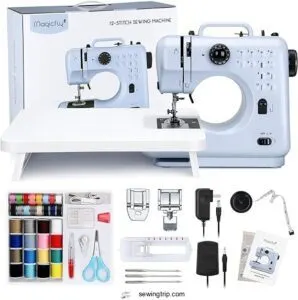
Starting your sewing journey? The Magicfly Portable Sewing Machine is your perfect beginner-friendly sidekick.
With 12 built-in stitches, including straight and zigzag, plus a reverse sewing function, it’s got your basics covered.
Three needle types handle fabrics from silk to denim, while a printed threading guide makes setup a snap.
Lightweight and compact, it’s easy to store or take on the go. Powered by batteries or an adapter, it’s ready wherever inspiration strikes—think of it as your portable sewing coach!
Best For: Beginners looking for a lightweight, portable sewing machine with simple features and versatile functionality.
- 12 built-in stitches, including reverse sewing for ease of use.
- Compact and portable design with battery or adapter power options.
- Printed threading guide for quick and simple setup.
- Limited to basic stitch patterns compared to advanced machines.
- May struggle with heavy or thick fabrics beyond 2mm.
- Lacks advanced features like automatic needle threading or quilting feet.
2. Singer Stitch Quick Hand Mending Machine
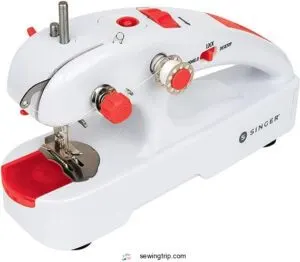
Ever find yourself with a loose hem at the worst time?
The Singer Stitch Quick Hand Mending Machine is like a sewing superhero in your bag.
Its cordless, ergonomic design makes it easy to grab and go, powered by four AA batteries.
The built-in storage compartment keeps essentials handy, while the safety switch prevents mishaps.
Switch to tabletop mode for longer fixes.
Perfect for quick T-shirt repairs or light fabrics, but don’t expect it to tackle heavy-duty jobs.
Best For: Quick, on-the-spot repairs and light sewing tasks for beginners or occasional users.
- Compact and portable for easy use and storage.
- Cordless design powered by AA batteries for convenience.
- Built-in storage compartment for essential sewing tools.
- Not suitable for heavy fabrics or frequent use.
- Steep learning curve for precise stitching.
- Mixed user feedback on reliability and performance.
3. Brother XM2701 Sewing Machine
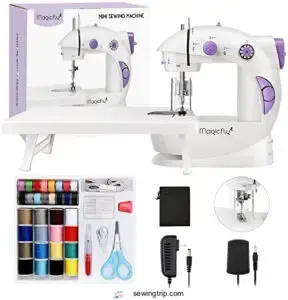
In terms of versatility in a portable package, the Brother XM2701 shines.
With 27 built-in stitches, you can tackle everything from mending tears to adding decorative flair.
The automatic needle threader saves you from squinting battles, while the jam-resistant drop-in bobbin keeps your projects frustration-free.
Weighing just 12.6 pounds, it’s lightweight yet powerful enough for cotton and denim.
Plus, the 6 presser feet handle zippers, buttonholes, and more.
One key benefit is its convenience of use, making it ideal for beginners.
Need help? Brother’s lifetime technical support is just a call away!
Best For: Beginners and casual sewers looking for a lightweight, portable sewing machine with versatile stitch options.
- 27 built-in stitches including decorative and zigzag options.
- Automatic needle threader and jam-resistant bobbin for ease of use.
- Lightweight and portable at just 12.6 pounds.
- Not powerful enough for heavy fabrics like leather.
- Limited to basic sewing functions despite versatility.
- May require practice to master the 6 presser feet.
Features to Consider in Small Sewing Machines
When choosing a small sewing machine, you’ll want to focus on features that match your needs, like stitch options and ease of setup.
A lightweight design is great, but it’s just as important to take into account how well it handles fabrics and stays stable while you work, considering ease of setup.
Stitch Options and Adjustability
The right stitch options and adjustability can turn sewing from a chore into a creative escape.
Mini machines may look simple, but the best ones offer features that make your projects shine.
- Stitch Length: Adjustable settings help with clean hems and precise seams.
- Stitch Width: Wider zigzag stitches add durability and flair.
- Tension Control: Say goodbye to tangled threads and hello to smooth stitching.
- Needle Positions: Perfect for tricky fabrics or detailed work.
Look for models with versatile stitch settings like zigzag stitches or multiple builtin stitches.
Using a machine with adjustable stitch width offers complete control over sewing projects.
Even compact machines can handle impressive tasks if equipped with thoughtful sewing features, making them a handy sidekick for creative souls.
Built-in Lighting and Thread Cutters
Good lighting makes all the difference when using a portable sewing machine.
A built-in LED light brightens your workspace, helping you tackle dark fabrics or late-night projects without straining your eyes. Pair that with a handy thread cutter, and you’ll breeze through tasks like a pro.
These features aren’t just conveniences—they’re game-changers for visibility improvement and threading ease. Plus, they add safety features by reducing scissor mishaps.
A dedicated sewing machine lamp can further enhance the sewing experience. With these sewing accessories, your builtin stitches shine, and every project feels smoother and more enjoyable.
Bobbin Winding Capabilities
Bobbin winding on a portable sewing machine makes setup a breeze.
Forget tangled messes with these smart features:
- Automatic Bobbin Winding: Full bobbins, zero guesswork. Many machines stop winding when full!
- Consistent Bobbin Tension: For smooth stitches, proper bobbin winding speed is key.
- Bobbin Size Compatibility: Check sizes and materials for trouble-free threading during travel sewing.
Ready to stitch stress-free? Choose wisely!
Fabric Thickness Handling
Handling fabric thickness with a portable sewing machine is like balancing strength with finesse.
These machines can sew lightweight fabrics, denim, or multiple layers with the right techniques and care. They may not conquer thick leather, but they’ll impress with everyday materials.
- Check sewing tension: Adjust it to avoid stitching issues on dense fabrics like denim.
- Use the right needle: A stronger needle works best for denim, quilting, or layered projects.
- Stitch length matters: Longer stitches prevent jams on thick fabrics, while shorter ones suit lightweight materials.
- Take it slow: Guiding thicker fabrics patiently guarantees better results.
With these tips, your machine can handle thick fabrics confidently, transforming your sewing adventures with ease.
Ease of Threading and Setup
Setting up a portable sewing machine shouldn’t feel like solving a puzzle.
Models with an automatic needle threader and clear threading guides are lifesavers, eliminating threading difficulty and saving setup time.
Features like a top-drop bobbin guarantee easy bobbin access, while quick-set options keep jams away.
Look for machines with numbered threading paths and a user-friendly tension adjustment dial—these make even beginners feel like pros in no time.
Manuals should be clear and easy to use, avoiding guesswork.
When threading is simple, you’ll spend more time stitching and less time squinting or struggling with setup!
Noise Levels and Stability
If you’re sewing late at night, a quiet, stable machine is essential.
A portable sewing machine is perfect for small spaces, but it’s worth choosing one that’s designed with noise and vibration in mind.
Here’s what to prioritize:
- Motor Noise: Seek models with quiet motors for peaceful sewing.
- Vibration Reduction: Built-in dampeners keep stitching smooth.
- Surface Grip: Non-slip feet guarantee stability on any tabletop.
- Frame Rigidity: A solid build prevents wobbling, boosting stitch consistency.
No more noisy, shaky distractions!
Limitations and Alternatives to Mini Sewing Machines
While mini sewing machines offer great portability, you’ll find they’ve limitations like fewer stitch options and lower durability for heavy fabrics.
You can consider manual sewing tools for basic repairs or invest in compact full-size machines if you need more features without sacrificing too much space, which can be a great option for those who need more features.
Limited Stitch Variety and Quality
After exploring feature considerations, let’s look at what these machines can’t do.
Mini sewing machines offer convenience at the cost of stitch functionality. You’ll typically find just basic straight and zigzag stitches, with many portable sewing machines lacking reverse capabilities.
Stitch consistency can be problematic on these quick stitch machines, especially when working with thicker fabrics. Your seam durability might suffer compared to full-sized models.
While perfect for simple travel repairs on lightweight materials, these compact companions aren’t suited for project complexity beyond basic mending. Think of them as your handy on-the-go fix rather than your primary workshop tool.
Durability Concerns
While mini machines offer impressive portability, their durability often falls short of their full-sized cousins. The trade-off for that travel-friendly design? Less robust construction.
- Plastic frames lack the frame stability of metal ones, causing alignment issues after repeated use
- Motor lifespan typically maxes out at 2-3 years with regular projects
- Material quality varies dramatically between brands, with budget options using thinner components
- Repair options are limited, as many portable sewing devices are designed to be replaced rather than fixed
Your best portable sewing machine mightn’t be the smallest one if you’re planning for long-term use. Consider how often you’ll actually need that on-the-go functionality. These machines are user-friendly because of their simple, easy controls. They offer a convenient way to sew, making them ideal for certain situations, but it’s essential to weigh the benefits against the potential drawbacks, including limited repair options and variable material quality.
Manual Alternatives for Simple Mending
Beyond portable sewing devices, reliable manual options exist for your mending needs.
When your mini machine isn’t available, these low-tech solutions shine:
- Needle & thread kits offer precision control for detailed mending jobs
- Fabric glue provides no-fuss, quick fixes for lightweight materials
- Iron-on patches deliver professional-looking repairs without electricity
These travel-friendly mending alternatives pack easily in any bag, proving sometimes the simplest solution is right at your fingertips.
Perfect for quick fixes when you’re on the go!
Investing in Full-size Machines for Serious Sewers
While simple hand mending works for quick fixes, you’ll eventually outgrow mini machines as your skills advance.
| Feature | Full-size Machine | Mini Machine |
|---|---|---|
| Durability | Metal frames, 15-20 years | Plastic parts, 2-5 years |
| Speed | 850+ stitches/minute | 300-500 stitches/minute |
| Projects | Quilts, garments, home décor | Small repairs, crafts |
| Investment | $200-600 | $30-150 |
| Versatility | 50+ stitches, multiple feet | 1-12 stitches, limited |
Brother CS6000i and SINGER Quantum Stylist 9960 offer advanced features that’ll transform your sewing from hobby to passion with full-size machines providing more versatility.
Frequently Asked Questions (FAQs)
Is mini sewing machine worth buying?
Over 80% of beginners find mini sewing machines perfect for learning basics.
If you value portability and quick fixes, they’re worth it.
Just don’t expect industrial power—think crafting, simple projects, or travel emergencies.
Is a portable sewing machine worth it?
Yes, portable sewing machines are worth it if you need convenience on the go.
They’re perfect for quick fixes, small spaces, or travel.
However, they’re limited in features compared to full-sized machines.
What is a good portable sewing machine?
Don’t reinvent the sewing wheel—opt for the Brother XM
It’s lightweight, jam-packed with 27 stitches, and comes with auto-threading.
Perfect for sewers who want portability without sacrificing features or performance.
What is the disadvantage of a mini sewing machine?
Mini sewing machines often lack reverse stitching, limiting durability for seams.
They’ve fewer stitch options, no automatic features, and lower power, making them less versatile for complex projects.
Perfect for quick fixes, but nothing fancy!
Is a mini sewing machine worth buying?
It depends on what you’re sewing.
If you need something portable for quick repairs or simple projects, they’re handy.
But for complex or heavy-duty tasks, they might leave you wishing for more power.
What is the disadvantage of mini sewing machine?
Truth be told, mini sewing machines struggle with durability, limited stitch options, and no reverse stitching.
They’re handy for small fixes but can’t handle heavy fabrics or complex projects, often leaving you feeling a bit hemmed in.
Are handheld sewing machines any good?
Handheld sewing machines work for quick fixes, like repairing a hem or ripped fabric on the go.
They’re portable and convenient, but don’t expect them to handle complex projects or thick materials easily.
Can a mini sewing machine sew clothes?
Picture hemming a skirt or stitching a tear—it’s doable with a mini sewing machine.
While these machines handle lightweight fabrics and basic tasks well, they’re not ideal for heavy-duty clothes or long-term projects.
Is it worth buying a mini sewing machine?
A mini sewing machine’s worth it if you need quick fixes, basic projects, or portability.
They’re compact, lightweight, and beginner-friendly but lack advanced features.
Great for travel or small spaces, not complex sewing.
Are portable handheld sewing machines any good?
It’s like having a band-aid for fabric—portable handheld sewing machines work for quick fixes.
They’re great for travel or small repairs, but their limited power may frustrate experienced sewers, as they struggle with heavy-duty tasks.
Conclusion
Why settle for bulky machines when a portable sewing machine small enough to fit your lifestyle can handle quick fixes and inspire creativity?
These compact tools are great for beginners, lightweight projects, and learning on the go.
Whether you choose a handheld option like the Singer Stitch Quick or the versatile Brother XM2701, you’ll enjoy convenience without sacrificing performance.
Perfect for everyday mending or crafting, a small portable sewing machine makes sewing easy and stress-free anywhere.
- https://sewingbecomeasy.com/are-mini-sewing-machines-good-for-home-use/
- https://boards.straightdope.com/t/how-is-the-effectiveness-of-mini-sewing-machines/754887
- https://www.quora.com/Are-portable-handheld-sewing-machines-durable-and-long-lasting-like-the-common-ones
- https://www.amazon.com/Mini-Sewing-Machine-Beginner-Multi-function/dp/B09HCC7LY5

